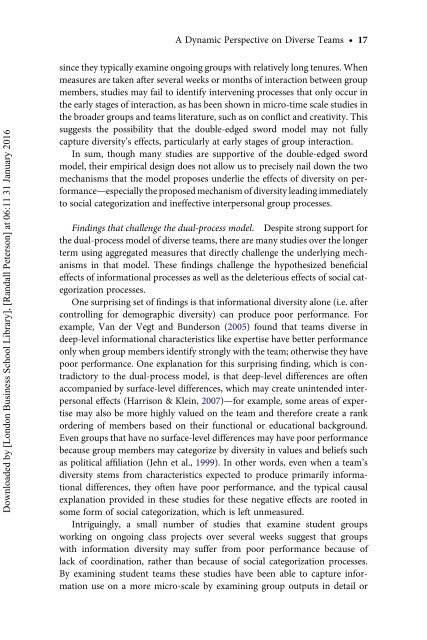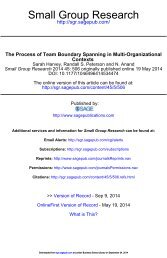A Dynamic Perspective on Diverse Teams: Moving From The Dual Process Model to A Dynamic Coordination-Based Model of Diverse Team Performance - Kannan Srikanth, Sarah Harvey & Randall Peterson
The existing literature on diverse teams suggests that diversity is both helpful to teams in making more information available and encouraging creativity and damaging to teams in reducing cohesion and information sharing. Thus the extant literature suggests that diversity within teams is a double-edged sword that leads to both positive and negative effects simultaneously.
The existing literature on diverse teams suggests that diversity is both helpful to teams in making more information available and encouraging creativity and
damaging to teams in reducing cohesion and information sharing. Thus the
extant literature suggests that diversity within teams is a double-edged sword
that leads to both positive and negative effects simultaneously.
You also want an ePaper? Increase the reach of your titles
YUMPU automatically turns print PDFs into web optimized ePapers that Google loves.
A <str<strong>on</strong>g>Dynamic</str<strong>on</strong>g> <str<strong>on</strong>g>Perspective</str<strong>on</strong>g> <strong>on</strong> <strong>Diverse</strong> <strong><strong>Team</strong>s</strong> † 17<br />
Downloaded by [L<strong>on</strong>d<strong>on</strong> Business School Library], [<strong>Randall</strong> Peters<strong>on</strong>] at 06:11 31 January 2016<br />
since they typically examine <strong>on</strong>going groups with relatively l<strong>on</strong>g tenures. When<br />
measures are taken after several weeks or m<strong>on</strong>ths <strong>of</strong> interacti<strong>on</strong> between group<br />
members, studies may fail <strong>to</strong> identify intervening processes that <strong>on</strong>ly occur in<br />
the early stages <strong>of</strong> interacti<strong>on</strong>, as has been shown in micro-time scale studies in<br />
the broader groups and teams literature, such as <strong>on</strong> c<strong>on</strong>flict and creativity. This<br />
suggests the possibility that the double-edged sword model may not fully<br />
capture diversity’s effects, particularly at early stages <strong>of</strong> group interacti<strong>on</strong>.<br />
In sum, though many studies are supportive <strong>of</strong> the double-edged sword<br />
model, their empirical design does not allow us <strong>to</strong> precisely nail down the two<br />
mechanisms that the model proposes underlie the effects <strong>of</strong> diversity <strong>on</strong> performance—especially<br />
the proposed mechanism <strong>of</strong> diversity leading immediately<br />
<strong>to</strong> social categorizati<strong>on</strong> and ineffective interpers<strong>on</strong>al group processes.<br />
Findings that challenge the dual-process model. Despite str<strong>on</strong>g support for<br />
the dual-process model <strong>of</strong> diverse teams, there are many studies over the l<strong>on</strong>ger<br />
term using aggregated measures that directly challenge the underlying mechanisms<br />
in that model. <strong>The</strong>se findings challenge the hypothesized beneficial<br />
effects <strong>of</strong> informati<strong>on</strong>al processes as well as the deleterious effects <strong>of</strong> social categorizati<strong>on</strong><br />
processes.<br />
One surprising set <strong>of</strong> findings is that informati<strong>on</strong>al diversity al<strong>on</strong>e (i.e. after<br />
c<strong>on</strong>trolling for demographic diversity) can produce poor performance. For<br />
example, Van der Vegt and Bunders<strong>on</strong> (2005) found that teams diverse in<br />
deep-level informati<strong>on</strong>al characteristics like expertise have better performance<br />
<strong>on</strong>ly when group members identify str<strong>on</strong>gly with the team; otherwise they have<br />
poor performance. One explanati<strong>on</strong> for this surprising finding, which is c<strong>on</strong>tradic<strong>to</strong>ry<br />
<strong>to</strong> the dual-process model, is that deep-level differences are <strong>of</strong>ten<br />
accompanied by surface-level differences, which may create unintended interpers<strong>on</strong>al<br />
effects (Harris<strong>on</strong> & Klein, 2007)—for example, some areas <strong>of</strong> expertise<br />
may also be more highly valued <strong>on</strong> the team and therefore create a rank<br />
ordering <strong>of</strong> members based <strong>on</strong> their functi<strong>on</strong>al or educati<strong>on</strong>al background.<br />
Even groups that have no surface-level differences may have poor performance<br />
because group members may categorize by diversity in values and beliefs such<br />
as political affiliati<strong>on</strong> (Jehn et al., 1999). In other words, even when a team’s<br />
diversity stems from characteristics expected <strong>to</strong> produce primarily informati<strong>on</strong>al<br />
differences, they <strong>of</strong>ten have poor performance, and the typical causal<br />
explanati<strong>on</strong> provided in these studies for these negative effects are rooted in<br />
some form <strong>of</strong> social categorizati<strong>on</strong>, which is left unmeasured.<br />
Intriguingly, a small number <strong>of</strong> studies that examine student groups<br />
working <strong>on</strong> <strong>on</strong>going class projects over several weeks suggest that groups<br />
with informati<strong>on</strong> diversity may suffer from poor performance because <strong>of</strong><br />
lack <strong>of</strong> coordinati<strong>on</strong>, rather than because <strong>of</strong> social categorizati<strong>on</strong> processes.<br />
By examining student teams these studies have been able <strong>to</strong> capture informati<strong>on</strong><br />
use <strong>on</strong> a more micro-scale by examining group outputs in detail or
















